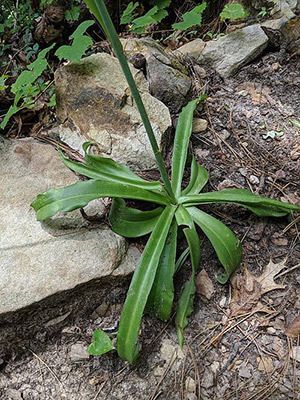False Aloe
Manfreda virginica
Family: Asparagaceae (Agave Family)
False Aloe (Manfreda virginica), also known as Rattlesnake Master or American Aloe, is a hardy, drought-tolerant native plant found in Texas, including Southeast Texas. Though its name suggests a resemblance to aloe, it is actually more closely related to agaves and yuccas. This unique plant adds visual interest to native gardens with its long, strap-like leaves and tall flowering spikes.
- Scientific Name: Manfreda virginica
- Common Names: False Aloe, American Aloe
- Family: Asparagaceae (Agave Family)
- Growth Habit: Perennial herb with a basal rosette
- Height: Foliage 1-2 feet; flower stalks up to 5 feet tall
- Leaves: Long, narrow, gray-green, often mottled or spotted
- Flowers: Tubular, greenish-white to pale yellow, fragrant, on tall spikes
- Bloom Time: Late spring to summer
- Wildlife Benefits: Attracts bees, butterflies, and night-flying moths
Habitat & Range in Southeast Texas
False Aloe naturally occurs in:
- Open Woodlands & Prairies: Thrives in sunny, well-drained areas
- Rocky Slopes & Sandy Soils: Prefers dry, nutrient-poor soils
- Savannas & Meadows: Often found in disturbed or open habitats
This species prefers dry to moderately moist soils and is highly drought-tolerant once established.
Ecological Importance
- Pollinator Attraction: Flowers provide nectar for a variety of pollinators, including moths.
- Soil Conservation: Thick root systems help stabilize soil in dry, erosion-prone areas.
- Low Water Use: Ideal for xeriscaping and sustainable landscaping practices.
Landscaping & Gardening Uses
False Aloe adds structure and drought resistance to native plant gardens:
- Xeriscapes & Rock Gardens: Thrives in hot, dry locations with minimal irrigation.
- Accent Plant: Striking foliage and tall blooms offer vertical interest.
- Pollinator Gardens: Attracts beneficial insects with its long-lasting blooms.
Planting & Care
- Sunlight: Full sun to light shade
- Soil: Well-drained, sandy or rocky soils
- Water Needs: Low; drought-tolerant once established
- Maintenance: Minimal; remove spent flower stalks to encourage tidy growth
- Companion Plants: Pairs well with Little Bluestem (Schizachyrium scoparium), Purple Coneflower (Echinacea purpurea), and Butterfly Milkweed (Asclepias tuberosa)
Fun Facts
- Despite its name, False Aloe is not a true aloe but is related to agave and yucca plants.
- The flowers are fragrant at night and attract moths, including hawk moths.
Conservation & Native Plant Advocacy
Adding False Aloe to your landscape supports pollinators and encourages water-wise gardening. This hardy plant is perfect for restoring native prairie ecosystems and creating sustainable, drought-tolerant landscapes.
Where to Find It
-
Interested in adding False Aloe to your garden? Check if this is in stock or add to cart to purchase directly from our Natives Nursery.




